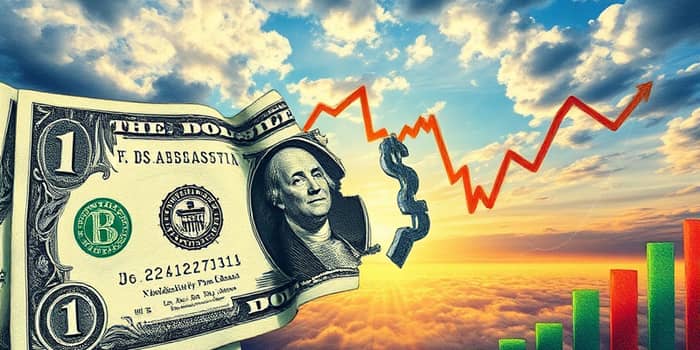
The US dollar, long a bastion of global stability, has shown signs of significant strain in recent months. While mid-2025 began with optimism after a robust first quarter, the currency’s trajectory has shifted. Market participants are now grappling with contradictory data points, prompting renewed debate over the dollar’s future role.
After peaking against most peers in early 2024, the DXY has eased back. Current levels reflect not just routine volatility but a substantive weakening trend over the year that may redefine international finance.
Data from June 27, 2025, highlights the dollar’s recent struggles. The DXY stands at 97.3369, modestly up from the prior session yet down 2.54% over the past month and 8.04% year-on-year. Against the euro, USD/EUR has fallen to 0.8697, a sharp drop from 0.9654 at January’s end.
These movements reflect broad-based dollar softness against major peers, underpinned by shifting investor priorities and external pressures.
The US economy entered 2025 on a high note, fueled by a pronounced demand drop-off in spending expected later this year. Early front-loaded purchases ahead of tariff fears have masked underlying weakness.
Key risk factors now weighing on growth include:
Collectively, these headwinds point to decelerating real GDP growth: projected from 2.8% in 2024 to 1.5% in 2025, then 1.3% in 2026. The probability of recession over the next 12 months stands near 35%, heightening uncertainty.
Unusual market behavior in 2025—where US stocks, bonds, and the dollar have all declined simultaneously—signals a potential inflection point. J.P. Morgan analysts suggest the unwinding of role as the global reserve currency over the medium term.
Heightened policy uncertainty and geopolitical tensions are eroding confidence in US assets. Long-term models indicate the dollar could lose another 10–20% of its value against major peers over the next decade.
Despite near-term weakness, some recovery is expected. Market forecasts place the DXY near 99.60 by quarter’s end, possibly rising to 101.06 next year. Yet these levels fall well below historical peaks such as February 1985’s 164.7.
Analysts foresee shifting cross-rates over the long haul:
These projections reflect shifting policy dynamics and fiscal uncertainty that could reshape global capital flows.
Importers may welcome a weaker dollar, gaining purchasing power abroad, while exporters could face headwinds as US goods become cheaper internationally. Consumers might see modest relief in travel and foreign tourism costs, but domestic inflation pressures remain.
Companies heavily reliant on cross-border trade should consider hedging strategies to mitigate further currency swings. At the same time, policymakers must balance stimulus measures against inflationary risks.
In times of confusion, clear-headed analysis becomes invaluable. Stakeholders should monitor the following indicators closely:
By staying informed and flexible, investors and businesses can position themselves to weather fluctuations and seize emerging opportunities.
As the dollar’s journey unfolds, one truth remains: adaptability and foresight are the keys to thriving in a landscape of mixed signals and evolving economic tides. Embrace rigorous analysis, maintain prudent hedging, and stay attuned to global trends to navigate the currents ahead.
References













